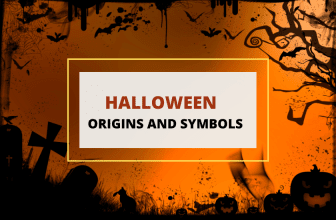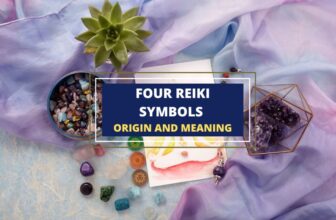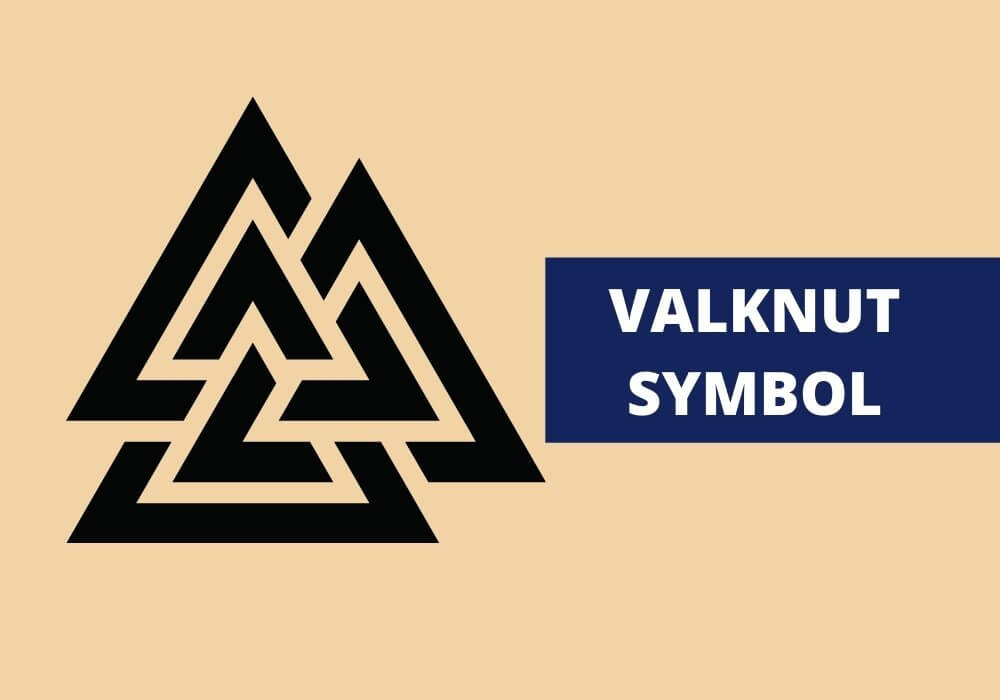
Table of Contents
The Valknut is a recognizable yet somewhat enigmatic symbol. This ancient Norse and Germanic sign goes so far back that archeologists and historians don’t even know its original name, as Valknut is a modern name that was given to it recently. It’s a compound word in modern Norwegian that means knot of those fallen in battle from the words varlor slain warrior and knut meaning knot.
The symbol was given this name partly because of how it looks and partly because of how it’s used on many ancient Norse artifacts. Here’s a closer look at the Valknut symbol.
The Valknut’s Intricate Design

The Valknut has several fringe variations but its two most prominent designs are both comprised of three interlocking triangles.
Very often, the triangles create a tricursal form meaning that each of the triangles is depicted as its own separate shape with them simply interlocking with each other.
The other common appearance is a unicursal shape where all three triangles are actually comprised of the same line.
In either case, the variations of the Valknut look very similar. There are six sharp 60o angles, two pointing upward, two pointing downward to the left, and two – downward to the right.
The difference is that in the tricursal design there are also three more angles in the center of the symbol, either hidden behind the interlocked sides of the triangles or showing behind them. With the unicursal design, however, there are no inner angles as the line keeps going from one triangle to the next.
Other similar designs include the Trefoil knot, the Triquetra, and the Borromean rings. There’s also the English Saint John’s Arms symbol. These aren’t Valknuts but are simply designed in a similar manner.
The Valknut Symbol Throughout History
The Valknut is seen on many artifacts from ancient Germanic and Scandinavian cultures but its original name remains unknown as it was never written next to the symbol. Its meaning also isn’t 100% clear although archeologists and historians have managed to piece quite a lot together based on the context surrounding the different uses of the symbol.
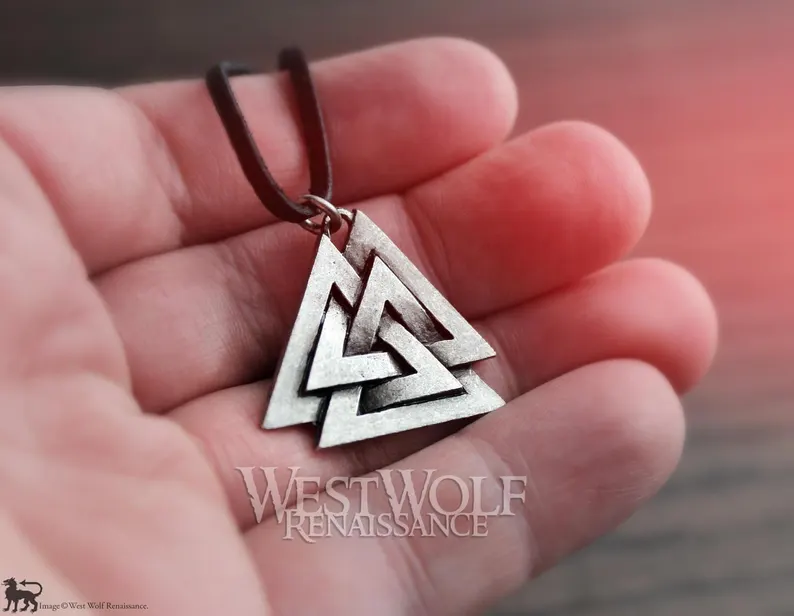
Two of the more famous ancient artifacts where original Valknuts can be seen include the Stora Hammars I stone and the Tängelgårda stone. Other good examples are the Nene River Ring, the wooden bed in a Viking Age Oseberg ship buried near Tønsberg, Norway, and some Anglo-Saxon gold finger rings dated to around the 8th or 9th century AD. From most of these artifacts have emerged two main theories about the Valknut’s original meaning:
1. Odin’s Mental Binds
The most popular and widely accepted as the most likely interpretation of the symbol is that it’s related to a cult of the dead. That’s why it’s given its modern name – “knot of those fallen in battle.”
The reasoning is that in most of its historic uses, the Valknut is shown near the images of dead warriors, on memorial stones, and on other runestones and artifacts associated with death and burials. Plus, some of the aforementioned Valknut-like symbols are also often found near burial grounds in other cultures related to the Norse and Germanic tribes such as the Anglo-Saxons of that time.
Additionally, the Valknut is often shown together with the Norse god Odin. Even when Odin isn’t shown directly, the Valknut is often shown together with horses and wolves, two animals often associated with the deity.
The possible connection between Odin and the Valknut is not surprising to historians because, in Norse mythology, Odin is a psychopomp, i.e. the guide of the souls of the dead. In many Norse legends, it’s either Odin or his valkyries that help guide the fallen Norse warriors to Valhalla, Hel, or to another of Norse afterlives.
In addition to this connection, the Valknut has also been associated with Odin’s “mental binds”. In many Norse myths, the deity has been shown to have the ability to “lay bonds upon the mind” rendering warriors helpless in battle. These same mental binds could also be used to loosen the tensions of fear and strain.
2. Hrungnir’s Heart
Another theory that’s also worth considering is that the Valknut can be Hrungir’s heart. Hrungnir “The Brawler”, from the Snorri Sturluson’s Prose Edda Icelandic poems, was a warrior that once battled Thor and was killed by him. Hrungnir’s heart was described in this peculiar way:
“Hrungnir had a heart made of hard stone and pointed with three corners, just like the carved symbol which has been called Hrungnir’s heart ever since.”
That is a pretty general description – all it says is that Hrungnir’s heart had a triangular shape. Nevertheless, it’s still an interesting connection. Besides, it’s also possible the Valknut is actually both and Hrungnir’s heart had precisely that shape because he was a warrior and he was slain in battle.
The Valknut is very prominent in modern Heathenry with many other even more obscure meanings often theorized about it. It’s also been used by some white nationalist groups as a symbol of their Germanic heritage and “warrior past”. However, this use of the symbol hasn’t gotten to a point of tainting the Valnut, like the Swastika.
Symbolism of the Valknut
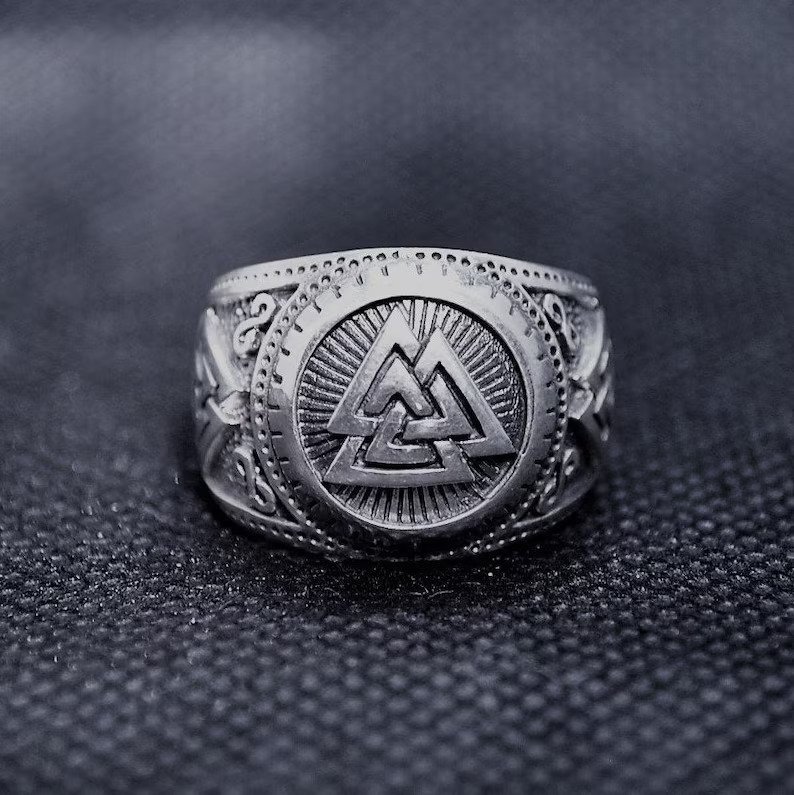
Keeping all the above in mind, the Valknut can be seen to represent the following:
- Odin: The god of war and the granter of victory or defeat.
- Hrungnir’s Heart: He was the spirit of the night, darkness, winter and the grave
- A Warrior’s Death: This, by extension, symbolizes fearlessness, courage, bravery, strength and fighting the good fight.
- Reincarnation: If you interpret each triangle as one phase of the life-death-rebirth cycle, the Valknut can be seen as a representation of the eternal cycle of life, where each end is just the beginning of another journey.
- The Three Realms: The three interlinked triangles are believed to represent the connection between Heaven, Hell and Earth.
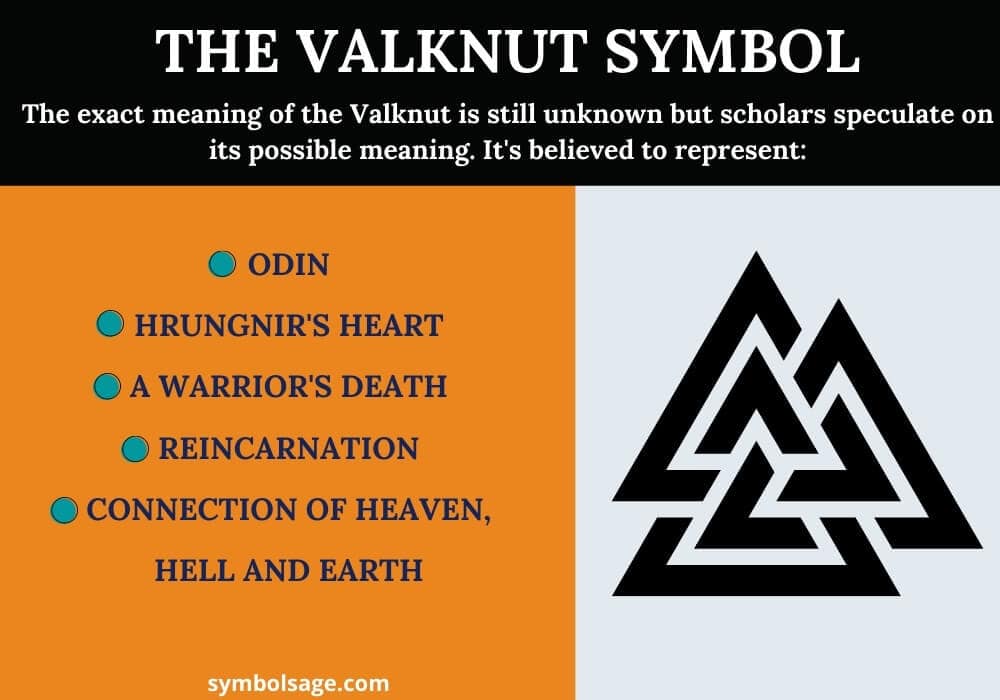
How Is the Valknut Used Today?
Despite its ambiguous meaning and probably thanks to its captivating design, the Valknut is quite a popular symbol today.
The Valknut is a strong and powerful looking symbol, with its three triangles and many points. As such, it’s a popular symbol for tattoos, representing strength, power, warriors and fearlessness. It’s also a popular symbol on clothing and in jewelry designs. It’s also used as the logo for several industries and some sports teams, notably in Germany.
12 Valknut FAQs
Popularly known as Odin’s Knot, the Valknut symbol is one of the symbols of the Norse Vikings, shown by three interconnected triangles. It exists in two forms: the Borromean form and the Unicursal form. While the former shows three intersected but separate triangles, the latter is drawn with a single line. Nonetheless, both enjoy the same meanings in archaeology.
The Valknut is the modern name given to the symbol and is derived from other words, “Valr” and “Knut” which means a “slain warrior” and “a knot”. Hence, it interprets as “Knot of Slain Warriors.”
The Valknut represents the passage from life to death and the afterlife. That is, it is used to send the souls of the dead to the afterlife. It also depicts the power of the god to knot and unknot.
Odin, the father of Thor according to Norse mythology, is referred to as the god of war and the dead. Since the symbol represents the passage of souls to the afterlife (the Valhalla), it is said to be related to Odin. In fact, it explains in part why the Valknut is also known as Odin’s Knot.
Death is often viewed as a bad occurrence. Therefore, the Valknut symbol is considered bad by some, and is said to attract misfortune. On the other hand, as it symbolizes fallen soldiers, it also represents bravery, courage, strength, and battling evil.
There are no literary sources that confirms the existence of the Valknut symbol, which means that it may be a more recent symbol. However, scholars are still divided on this and it’s difficult to know.
No, a tattoo is simply ink and a symbol only has the meaning that we decide to give it.
The three triangles’ nine edges show how the nine kingdoms are connected. The three worlds of Earth, Heaven, and Hell are intertwined. The three triangles represent this entwined relationship.
Numerous artifacts (the Tangelgrda stone, Nene River ring, and Stora Hammars I) from prehistoric Scandinavian and Germanic cultures feature the Valknut. However, its earliest form is unclear because it was never recorded with the symbol.
There is no evidence that the Valknut originates from any religion. However, many have asserted that Heathenry, a modern religion influenced by ancient Germanic paganism, uses the Valknut sign as a holy emblem.
Additionally, it has been proposed that the Valknut represents Hrungnir’s Heart, a symbol described by Snurri Sturluson in the ‘Prose Edda’. He says the heart has three pointed corners and is made of stone. Considering that Hrungnir was a god of winter, darkness, and the grave, this makes sense in the context of death as well. However, the majority of academics reject this view in favor of the symbol’s affiliation with Odin.
The Vikings had different symbols to explain different things. The Valknut is an example and is the Vikings’ symbol of life. The Vikings believe Valhalla is prepared as the afterlife space for warriors who died on the battlefront. This explains why dying or sick believers are killed, or a person kills himself, hoping Odin would be convinced into sending them into Valhalla.
Wrapping Up
The Valknut is a simple yet meaningful design. It’s typically associated with warriors, the dead and with Odin, the god of war and the dead. It continues to be a popular design in the modern world, typically chosen as a tattoo symbol or for masculine pendants and other jewelry.
Related articles
Ginfaxi – Icelandic Swastika-Like Symbol of Good Luck and Wrestling
What Is the Triple Horn of Odin? – History and Meaning
Troll Cross – Meaning and Origins
Vegvisir Symbol – Meaning, Origins and History






